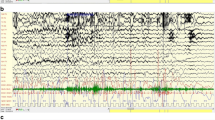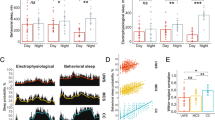Abstract
Sleep paralyses are viewed as pure motor phenomena featured by a dissociated state in which REM-related muscle atonia coexists with a wakefulness state of full consciousness. We present a 59-year-old man diagnosed with narcolepsy experiencing sleep paralysis, who failed to establish the boundaries between real experience and dream mentation during the paralysis: the patient’s recall was indeed featured by uncertainty between real/unreal and awaken/dreaming. Hereby, we suggest that sleep paralysis may represent a more complex condition encompassing a dissociated state of mind together with the dissociative motor component. Neurophysiological data (spectral EEG analysis corroborated by cross-correlation analysis) reinforce the idea that the patient was in an intermediate state of mind between wake and REM sleep during the paralysis. The persistence of local impaired activity proper of REM sleep in cortical circuits necessary for self-reflective awareness and insight, in conflict with wakefulness-related activation of the remaining brain areas, could account for disrupted processing of afferent inputs in our patient, representing the underlying pathophysiologic substrate for patient’s failure to establish the boundaries between real experience and dream mentation.


Similar content being viewed by others
References
American Academy of Sleep Medicine (2005) International classification of sleep disorders, 2nd edn. Diagnostic and coding manual. American Academy of Sleep Medicine, Westchester
Girard TA, Cheyne JA (2006) Timing of spontaneous sleep paralysis episodes. J Sleep Res 5:222–229
Mahowald MW, Schenck CH (2005) Insights from studying human sleep disorders. Nature 437:1279–1285
Duppils GS, Wikblad K (2007) Patients’ experiences of being delirious. J Clin Nurs 16:810–818
Terzaghi M, Sartori I, Tassi L, Didato G, Rustioni V, LoRusso G, Manni R, Nobili L (2009) Evidence of dissociated arousal states during NREM parasomnia from an intracerebral neurophysiological study. Sleep 32:409–412
Maquet P, Ruby P, Maudoux A, Albouy G, Sterpenich V, Dang-Vu T, Desseilles M, Boly M, Perrin F, Peigneux P, Laureys S (2005) Human cognition during REM sleep and the activity profile within frontal and parietal cortices: a reappraisal of functional neuroimaging data. In: Laureys S (ed) Progress in brain research, vol 50. Elsevier, Amsterdam, pp 219–227
Braun AR, Balkin TJ, Wesenten NJ, Carson RE, Varga M, Baldwin P, Selbie S, Belenky G, Herscovitch P (1997) Regional cerebral blood flow throughout the sleep–wake cycle. An H2(15)O PET study. Brain 120:1173–1197
Voss U, Holzmann R, Tuin I, Hobson JA (2009) Lucid dreaming: a state of consciousness with features of both waking and non-lucid dreaming. Sleep 32(9):1191–1200
Author information
Authors and Affiliations
Corresponding author
Rights and permissions
About this article
Cite this article
Terzaghi, M., Ratti, P.L., Manni, F. et al. Sleep paralysis in narcolepsy: more than just a motor dissociative phenomenon?. Neurol Sci 33, 169–172 (2012). https://doi.org/10.1007/s10072-011-0644-y
Received:
Accepted:
Published:
Issue Date:
DOI: https://doi.org/10.1007/s10072-011-0644-y




